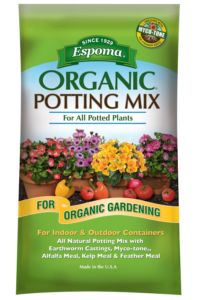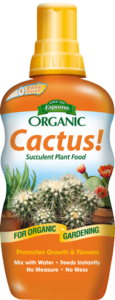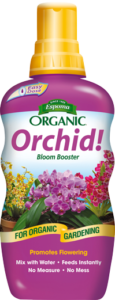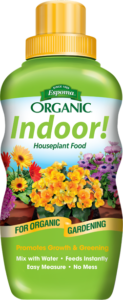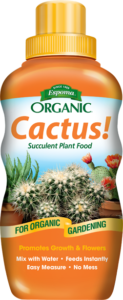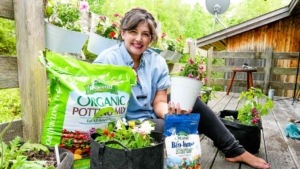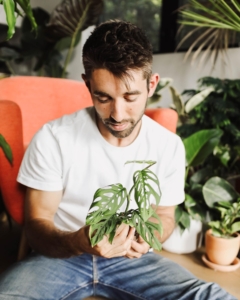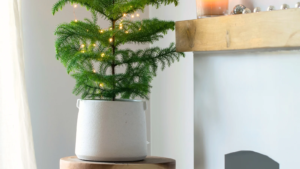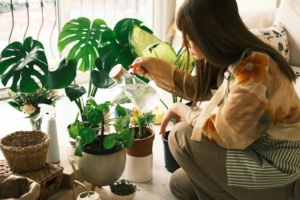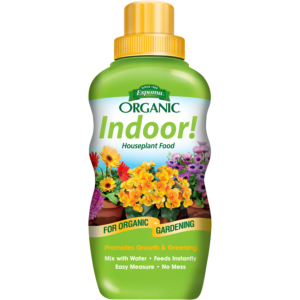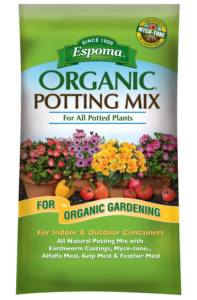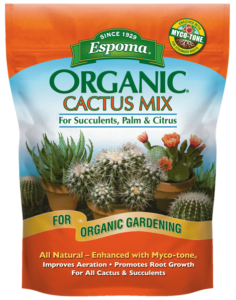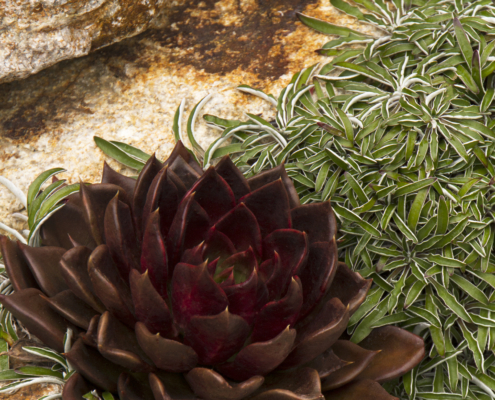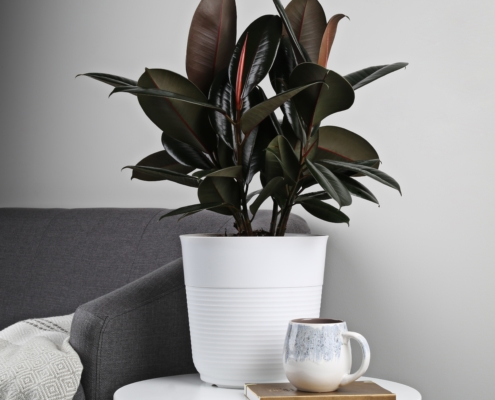Video: Arranging Succulents in an Urn with Garden Answer
/in Espoma Videos, Garden Answer, Indoor GardeningStarting a fun new succulent project? Take a tip from Garden Answer and kick things off with Espoma Organic Cactus Mix, which is made specifically for cactuses and succulents.
Featured Products:
Hoya Plants: Caring for Hoya
/in Indoor Gardening, Indoor Gardening, Succulents, SucculentsHoya have been popular house plants for decades and with good reason. They are extremely long-lived, have a classic, deep green, vining foliage and produce fragrant, light pink and red star-shaped flowers. Because of their thick waxy, foliage they are often called wax plants or sometimes porcelain flower referring to the unique texture of the flowers.
These tropical vining plants have a few requirements in order to thrive but nothing too hard. Give them bright, indirect light, humidity and a light touch when it comes to watering. Use a potting mix that allows for good air circulation around the roots. Read on for the best recipe for success.
Light
Select a place that gets bright, indirect light. Don’t let their waxy foliage fool you. They are not succulents and can’t take harsh afternoon light. They will grow in lower light situations but it’s unlikely they will bloom.
Soil and Repotting
Potting soil with good air circulation is very important for Hoya. To create a perfect blend mix equal parts of Espoma’s organic Cactus Mix, Orchid Mix, and Perlite. Hoya like to be pot-bound or crowded in their pots. They will only need to be repotted every two or three years.
Water
Water regularly with room-temperature water, spring through summer. Let the top layer of soil dry between watering. In the fall and winter growth naturally slows down and they won’t use as much water. Water sparingly during fall and winter, give them just enough that the soil doesn’t dry out completely. Too much water can cause flowers to drop.
Humidity
Hoya are tropical plants that thrive in humid conditions. Use a humidifier to bring the humidity levels up, especially in winter when indoor air tends to be dry. A saucer with gravel and water also provides humidity as the water evaporates. Misting with room-temperature water also helps but avoid spraying the flowers.
Temperature
Keep the room temperature warm year-round, try not to let it drop below 60 degrees Fahrenheit. It’s also best to keep plants from touching cold windows and away from heating and cooling vents.
Pruning
Prune in spring before vigorous growth begins. The stems with no leaves are called spurs and shouldn’t be removed. Flowers are produced on the same spurs year after year. Hoya are vining plants that will happily cascade from a shelf or window sill. Conversely, they are often trained onto trellises that are either vertical or circular, giving the impression of a more robust plant.
Fertilizer
Espoma’s Orchid! liquid fertilizer is perfect for Hoya. Feed once a month from spring through fall.
Here are links to other blogs and videos we hope you will enjoy:
Hoya Tips and Propagation from Homestead Brooklyn
A Healthy and Happy New Year with Plants
Espoma Products for Hoyas
Plant Care Is Self-Care: Nurture Yourself as You Nurture Your Plants
/in Blog, Indoor Gardening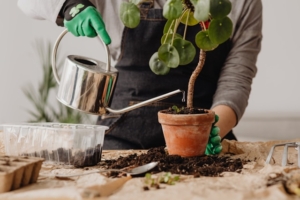
Ever notice how a moment spent tending your plants feels like a mindful pause in a busy day? You’re not just watering—you’re nurturing calm, presence, and connection. We believe that caring for your green companions is one of the most natural forms of self-care. And just like you thrive on nourishing food, your plants thrive when you feed them regularly with Espoma Organic fertilizer —gentle, effective, and safe for people, pets, and the planet.
The Science Behind the Serene
Sharper Mind + Better Mood
Studies show that being around plants can boost memory and attention by about 20%, while reducing background noise and enhancing productivity and creativity—especially in home or little work-from-home nooks.
Soil for the Soul
That earthy scent? It comes from microbes like Mycobacterium vaccae (lovingly nicknamed “outdoorphins”), and they don’t just feed your plants—they may help boost your mood and immunity, too.
Self-Care That Doesn’t Feel Selfish
Pulling weeds, misting leaves, or simply observing new growth—these are gentle rituals that anchor us in the now. As one soothing tip from our brand partner, Maria Failla of Growing Joy with Maria, reminds us:
“Use watering or caring for them as an excuse to get up from your computer and take some ‘me-time’—because plant care is self-care.”
Pair that with feeding your plants Espoma Organic fertilizer, and you’re nourishing life in every sense.
Indoor Joy: Caring for Your Plants with a Gentle Boost
Your indoor plants do more than brighten a room—they improve your air, calm your mind, and remind you to slow down. To keep them thriving year-round, a little extra nourishment goes a long way.
That’s where Espoma Organic Indoor! liquid fertilizer comes in. This gentle, balanced formula is made from natural ingredients and feeds instantly, giving your leafy friends the nutrients they need for lush growth and vibrant color—even in the lower light of winter months.
Self-Care Tip: Pair your plant feeding with your own wellness ritual. Set a reminder every 2–4 weeks to water and feed your plants, then take a few minutes to enjoy a cup of tea nearby. Watch how your plants respond over time—you’ll notice deeper greens, healthier new leaves, and a little spark of joy in your day.
Festive Downtime: Holiday-Ready Green Retreats
During the busy holiday season, a mini Christmas cypress or Norfolk Island Pine—with its fresh sap-like scent—can be both a peaceful décor choice and a mindful project. Pot it up in our Espoma Organic Potting Mix, give it a slow sip of water, and feed it with an organic fertilizer like Indoor! for lasting joy. It’s a gift that grows for you, not just from you.
Fresh Ways to Deepen Plant-Based Self-Care
-
Micro-Meditation Moments
Set a daily two-minute ritual—touch the soil, check a leaf, breathe deeply. Call it a “plant-powered reset.” -
Mini Salad Gardens with Maria Failla
Maria Failla of Growing Joy with Maria, makes self-care—and dinner—even simpler. She grows an entire salad (including herbs, lettuce, mini-tomatoes, and edible blooms) in a single container using Espoma Organic Potting Mix, Bio-tone Starter Plus, and Garden-tone organic fertilizer for steady nourishment. -
Create a Kitchen Corner of Calm
A small shelf of herbs like basil, lavender, or even mint provides an aromatic escape and practical joy when cooking. Watering and feeding them with organic fertilizer like Indoor! can become a lovely action in your daily rhythm. -
Mindful Mondays with Biophilia
Start your week by simply sitting with your plants—observing new buds, leaf shapes, and subtle color shifts. This biophilic practice connects you to growth and groundedness.
Let Your Care Shine Through
Plant care is not just about pretty greenery—it’s caring for yourself, too. You pause, breathe, tune in, and the soil responds. Whether it’s a festive tree, a potted herb, or a tranquil succulent, your green space is your sanctuary. And with a little love, light, and organic fertilizer, your plants—and your spirit—can truly thrive.
*****
Here are some of our other blogs and videos we think you will enjoy.
Give Some Green for the Holidays
Parenting Advice for New Plant Parents
Poinsettia Care Guide from Garden Answer
Featured Products:
Plant Parents: Add These Tropical Houseplants to Warm Your Soul
/in Indoor GardeningThe brightest part of winter may just be decorating your home for the season. While hot cocoa, holiday lights, and a cozy fireplace are traditional ways of warming your space, try thinking tropical this year. Your decorating doesn’t have to be the same every year, and holiday houseplants aren’t just limited to poinsettias.
It’s not a secret that many houseplants are tropical by nature. They feel right at home in places with year-round warmth and jungle-like conditions. So, bring some warmth and tropical flair to your space by adding one of these houseplants.
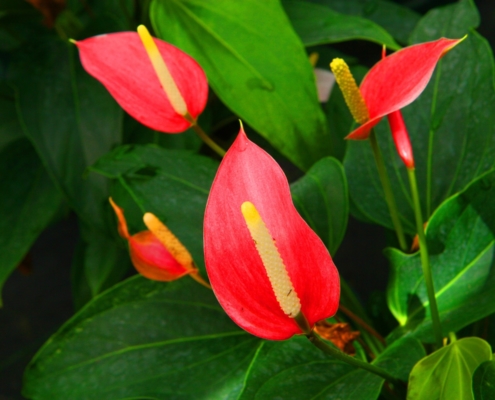
Anthurium
Anthuriums are elegant, easy-care plants with cheery blooms that last a long time. This show-stopping plant is a favorite for any romantic with its glossy, heart-shaped, pink leaves. Anthurium stands out from the crowd with blooms on and off all year. This exotic plant loves warmth and humidity.
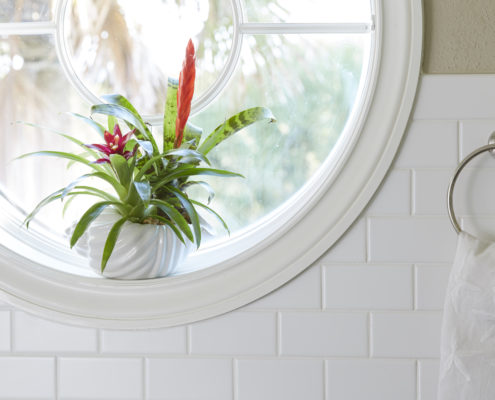
Bromeliad
This easy-to-grow houseplant makes for a perfect gift. It provides an exotic touch of red, orange, pink or purple to any home. Even with the thick foliage and wide leaves, it gives off a radiance that anyone will fall in love with. Be sure to use Espoma’s Orchid Potting Mix to allow proper drainage.
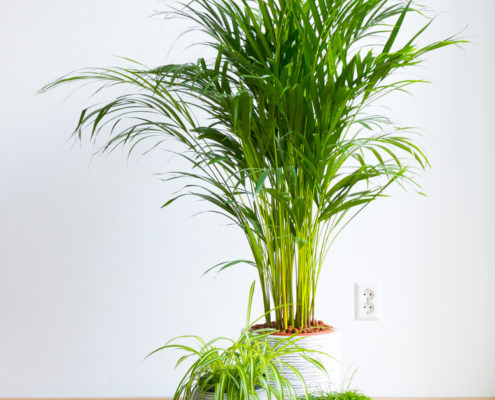
Palms
Majesty palms practically whisk you away to somewhere tropical. They thrive in the humidity and like to be kept evenly moist. Fertilize regularly with Indoor! Liquid plant food for faster growth. These are easy to grow and don’t require any pruning except for an occasional old frond.
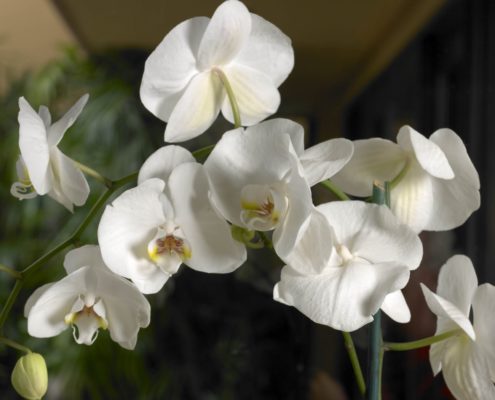
Orchids
Orchids can bloom for up to four months, making them great for adding some color and flair to any home. They love indirect light, a little bit of water, and to be away from any drafty windows, air vents, or ducts.
Plus, they will continue to rebloom every year with a little love and patience, and fertilizer.
An organic fertilizer, such as Espoma’s Orchid! Liquid plant food will help keep your blooms looking fresh and colorful year after year.
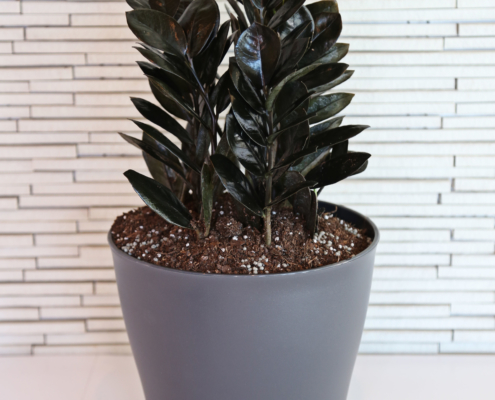
ZZ plant
This tough houseplant can survive even with the brownest of thumbs. You can put it anywhere in your home or office, and it will be happy to see you. It can even survive with only fluorescent lights and no natural light. Water when the top two inches of soil are dry. Don’t worry if you forget; it may start to drop some of its leaflets to conserve the water left, and will rebloom after a good drink.
Try these lowlight houseplants if you want greenery but lack light. https://youtu.be/SYXv_EcBdEA
Products for houseplants
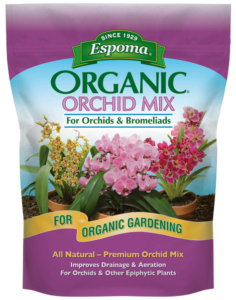
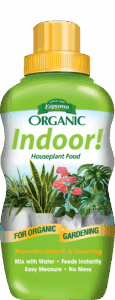

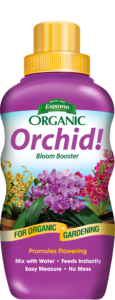
Rhipsalis Care and Propagation
/in Indoor GardeningJungle cacti sounds like an oxymoron but in this episode of Plant One on Me, Summer Rayne Oaks talks in-depth about this strange branch of the family. When you hear “cacti,” most people generally conjure images of the desert Southwest and prickly plants. Even so, 10 percent of cacti are epiphytic and live in jungles. That means that the cacti live on other plants and use them for support, but not for food. They get moisture and nutrients from the air. Despite growing in a jungle, they don’t get much water or much light.
There are 38 species of Rhipsalis native to tropical and subtropical America. Sadly, many of these species are threatened or endangered in their native range. Some may have even gone extinct before they were discovered. Plant parents can play a role in conservation by growing these plants and buying them from reputable sources.
For people that are not familiar with Rhipsalis, they look very similar to the Christmas cactus. They like bright, indirect light. The soil should be well-drained but not allowed to dry out completely. Summer creates her own soil blend for repotting made from equal parts of Espoma’s organic Potting Soil Mix, Orchid Mix, and Perlite. Espoma’s Cactus Mix would also work well. They are not heavy feeders, a quarterly dose of Cactus! is all they require.
Rhipsalis are surprisingly easy to propagate. They do flower and produce small berries. The seeds of which may be planted and will germinate at temperatures between 60-70 degrees Fahrenheit. They will often produce a root at the natural junction between the modified leaves. Simply lay that down on top of the soil and it will root in. Another method is to cut off a ‘leaf’ and let the wound callus over for a day or two and then tuck it into the soil about halfway. Try not to get too much water on these new plants or they could rot. If that does happen, just try again. Gardening is really about experimenting.
Here are more videos from Homestead Brooklyn we hope you will enjoy:
Hoya Care Tips and Propagation
Plants to Help You Get Some Rest
/in Blog, Indoor GardeningHouseplants are so much more than decorations. They help reduce stress and tension and create a relaxed and happy atmosphere. They absorb carbon dioxide and produce oxygen while purifying the air by removing toxins. They say we spend a third of our life sleeping, so let’s do it in the best possible environment, a room full of house plants.
The best plants for a healthy night’s sleep.
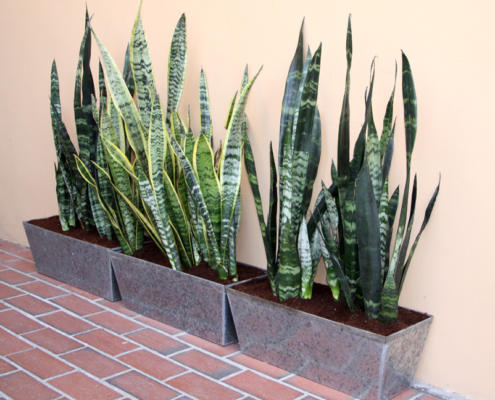
Snake Plant
Snake plants convert carbon dioxide to oxygen at night. It is also one of the easiest and most forgiving houseplants you can grow. Whether you have bright or low light, a snake plant will adjust to it. It doesn’t require much water and even if you forget to water it for a couple of weeks, it will still look great. Overwatering it is really the only way to kill it.
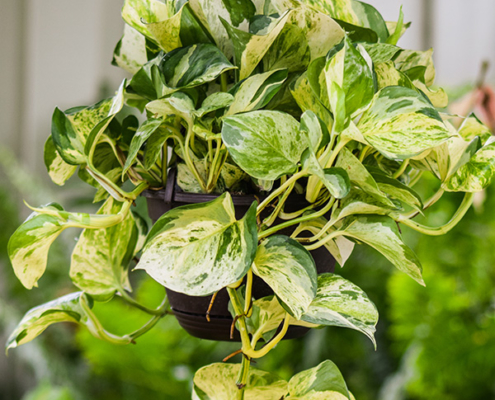
Golden Pothos
A study from NASA shows that pothos removes toxins, mainly carbon monoxide and formaldehyde from the air. This low-maintenance plant grows well in low light. Water it only when completely dry. Always pot your houseplants in quality potting soil like Espoma’s Potting Mix or a mixture of potting mix and Cactus Mix for plants like this that require excellent drainage.
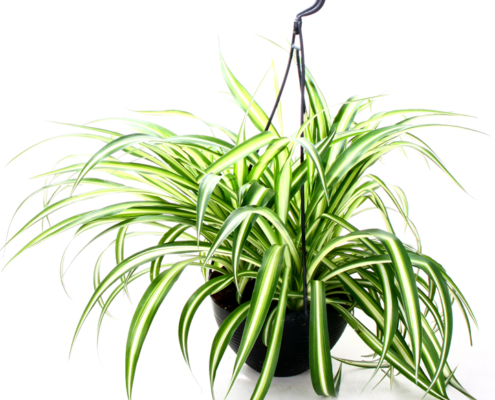
Spider Plant
The spider plant removes formaldehyde from the air, which is a common carcinogen found in many household products and items. This is another easy to grow selection that enjoys bright light, but will adapt to low light situations. Like all house plants, a regular schedule of fertilizing will help keep spider plants in tip-top shape. Organic liquid fertilizer like Espoma’s Indoor! works beautifully and has an easy dose cap, meaning you’ll never use too much or too little.
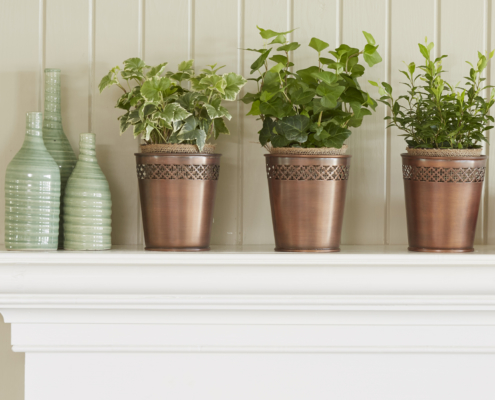
English Ivy
English ivy has the unique ability to clean the air of mold. Ivy is a trailing plant that you can train to grow up a trellis or let it cascade down from a shelf. It can be an aggressive plant outdoors, but inside it’s well behaved. Keep the soil moist, but not wet, and give it a place with indirect light.
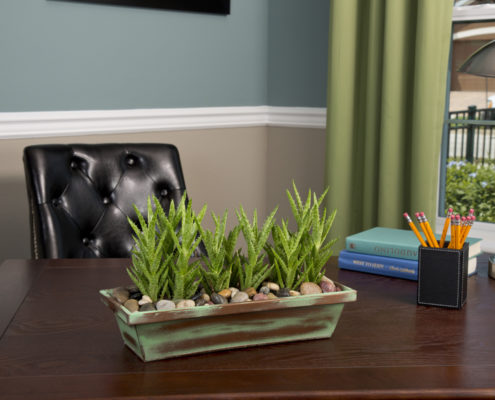
Aloe vera
Aloe has been used as a medicinal plant to heal: sunburn, cuts, insect bites, minor burns, and dry skin. It’s also an air purifier. Aloe likes bright light. Water it well every two weeks or when the soil feels very dry. Fertilize with Cactus! monthly to give it nutrients.
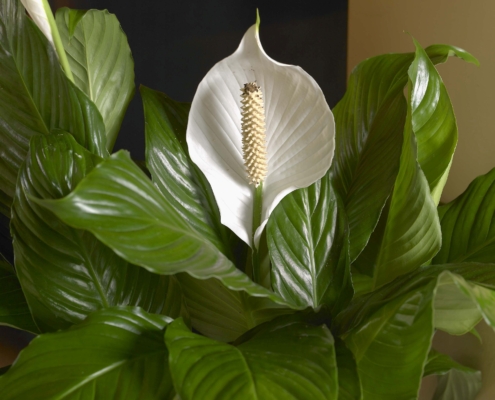
Peace Lilies
Peace lilies also made it on NASA’s list of toxin removing plants. They can absorb mold spores from the air into their leaves. It’s a pretty plant with calla-like flowers that likes bright light. Regular watering is a must (they’ll let you know when they’re thirsty by letting their leaves droop.)
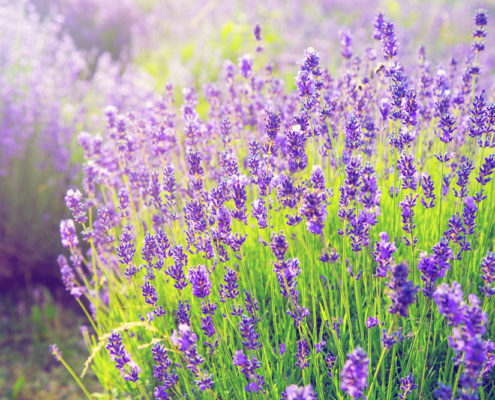
Lavender
Lavender has been used for centuries for its soothing, sleep-inducing properties. Victorian ladies used to stuff their pillows with lavender to relieve stress. Today you can find a wide array of lavender products to help whisk you off to sleep. Lavender isn’t often sold as a houseplant but you can grow it outdoors and harvest the flowers for the bedroom.
*****
Ready for more relaxing? Check out these blogs for ideas.
How to Decorate for Thanksgiving with Plants
Featured Products:
Millennial Pink Houseplant Roundup
/in Indoor GardeningIf you feel like your collection of tried and true houseplants is looking a little, well, green, then now’s the time to add some dramatic pink houseplants.
Millennial pink’s reign has extended well beyond its Pantone 2019 Color of the Year status. Choosing houseplants in this hue give it a timeless status.
Houseplant lovers and interior decorators are embracing pink houseplants like never before. Want or little pop of color to mix with your greens? Check out some of our favorites.
Plus, these pink plants will outlast any pink cut flowers.
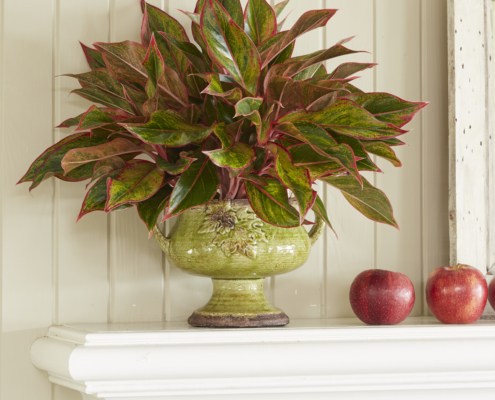
Colorful Aglaonema
Traditionally known as the Chinese evergreen, this houseplant has been bred to come deep green, silver, pink and red. It is slow growing, with large, narrow and glossy oval foliage. Keep in mind the lighter the variegation, the more light it needs. If you opt for dark green foliage, it can thrive in low light. Water when the top two inches of soil is dry and add humidity around the plant in the summertime. Use Espoma’s indoor! liquid plant food during the growing season to give it the nutrients it needs.
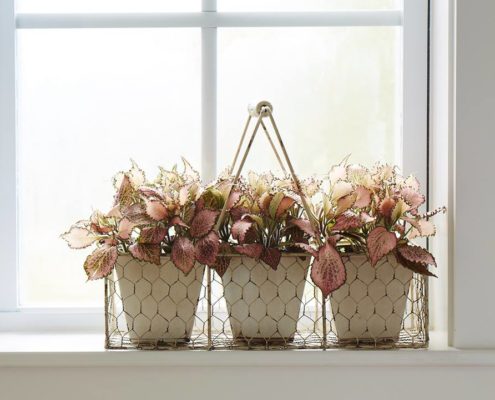
Fittonia
A small houseplant like Fittonia fits practically anywhere — from a tabletop to a window sill or a desk. It’s a good candidate for low-light spots in the home or office, too. Pink-variegated fittonias like ‘Frankie’ and ‘Mini Pink’ capitalize on the pink hues. Fittonia is a thirsty plant that wilts quickly when dry. Don’t worry, it will perk back up quickly after watering, but for the best keep moist for best results.
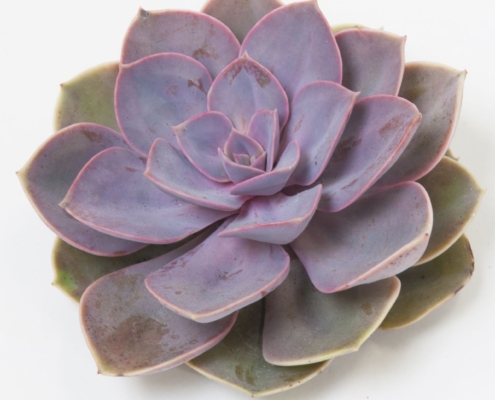
Afterglow Echevaria
This echeveria truly lives up to its name. With beautiful pastel pink and purple leaves, this succulent is a prize for any blush lover. Afterglow is perfect for indoor or outdoor containers. When growing succulents in containers, be sure to use Espoma’s Cactus Mix for best results.
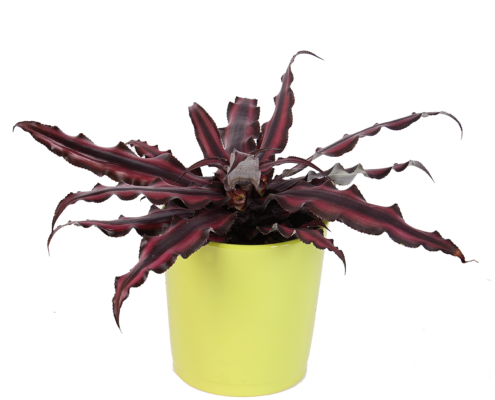
Earth Star
There are more than 1,200 varieties of cryptanthus and they come in many gorgeous shades of pink. It gets its common name from its star-like spread and need to grow in soil (many other bromeliads are air plants.) Earth star prefers low-water, bright light and an occasional feeding with an organic fertilizer like Espoma’s Indoor! Like other bromeliads, each cryptanthus blooms only once in its lifetime, and then it begins a slow dying process. Before it dies, new pups are produced that can be replanted.

Anthurium
Anthuriums are elegant, easy-care plants with cheery blooms that last a long time. Anthuriums are also efficient air purifiers, so a colorful Anthurium will bring a pop of color and breath of fresh air to the room. This show-stopping plant is a two-for for any romantic with its glossy heart-shaped, pink leaves. Anthurium stands out of the crowd with blooms on and off all year. Its flowers will last for months under the right conditions. This exotic plant loves warmth and humidity.
Not ready for such bright color just yet? Check out these low-light picks!
Espoma products for pink houseplants
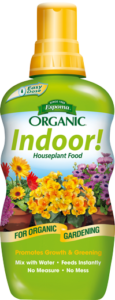
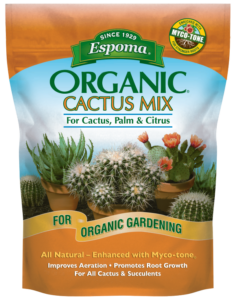
What’s an Aroid?
/in Indoor GardeningAroids are from the family Araceae and include many common houseplants like aglaonemas, monsteras, philodendrons, pothos and ZZ plants. While these plants tend to be “low light” indoor plants, they’re often understory plants in the wild.
Aroids come in all different sizes from the extra-large corpse flower to the desk-sized peace lily. You can usually spot them by their colorful, spiky blossoms. Each aroid blossom is made up of numerous tiny flowers clustered together on a “spadix,” that’s found within a curved, leaf-like “spathe.”
Some aroids have special talents, like being able to generate their own heat or being propagated in water. This family has long been swamp-dwellers that were able to adapt to regular floods, one of the reasons they’re an easy-care houseplant.
Many of these plants have waxy roots and leaves that prevent the plants from absorbing too much water. If you do choose to root your aroid in water for an extended period of time, remember that the longer they do, the harder it will be for them to adapt to soil conditions.
Many aroids have the same preferences, so they do well grouped together and make for easy beginner plants. These plants prefer medium light but will tolerate low light. Too much direct sun can cause them to get sunburn. They should be watered about once a week, allowing the top 1-2” of potting mix to dry out in between waterings.
The easiest aroids for new plant parents

Peace Lilly
The peace lily is an essential houseplant. Not only does it have stunning green foliage, but if given enough light, classic lily blooms will flower. They have air cleansing and cooling abilities, making them perfect as part of your air-cooling house plant team. Peace lilies prefer medium to low light and well-drained soil. For quality potting soil and houseplant success, try Espoma’s Organic Potting Mix. The biggest danger with peace lilies, and most plants, is over watering. The peace lily is a hardy, forgiving plant that will let you know when it needs water. It has a telltale droop to signal it’s thirsty. It will pop back up as soon as it gets the water it desires.

ZZ Plant
This is one tough houseplant! It can survive with only florescent lights and no natural light. Don’t worry if you forget to water it, it may start to drop some of its leaflets to conserve the water left and will rebloom after a good drink.
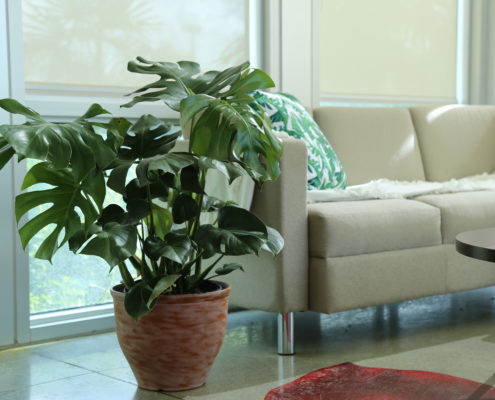
Monstera
Known as the split leaf philodendron, the foliage on this plant is striking. Being a tropical variety, this plant can survive lower light and higher humidity. It has large, lush, dark green foliage that stands out against a blank wall, making it one of the most popular plants of the year. Keep it near a window with indirect light and watch it grow.

Aglaonema
Also known as the Chinese evergreen, this houseplant can come in colors from deep green to silver to red. It is slow growing, with large, narrow and glossy oval foliage. When deciding where to put your aglaonema, keep in mind the lighter the variegation, the more light it needs. So if you’d prefer dark green foliage, it can thrive in low light. Water when the top two inches of soil are dry and add humidity by surrounding ags with other houseplants in the summertime or set pot on top of a saucer layered with stones and water. Use Espoma’s Indoor! liquid plant food during the growing season to give it the nutrients it needs.
Looking for more easy care houseplants? Check out Garden Answer’s favorite low light houseplants!
Espoma products for happy aroids
Gothic Gardening – The Darkest Plants
/in Indoor GardeningThese black beauties are some of the most sought after houseplants available today. While they’re certainly fitting for autumn décor, they’re stunning year-round additions to your collection. Use them to create dramatic accents in any room, alone or in combination with other favorite houseplants. They all prefer bright, indirect light. They tend to lose their deep coloring in low light locations. Keep them looking their best by feeding them every two to four weeks with an organic houseplant food like Espoma’s Indoor! fertilizer.
Each of the plants on this list requires good drainage. Make sure containers have a drainage hole and consider setting them on a saucer of pebbles to catch any run-off water. The potting soil is also important. A 50/50 mix of Espoma’s Potting Soil Mix and Espoma’s Cactus Mix would be ideal. The potting mix will help hold nutrients while the cactus mix will ensure good drainage.

Raven ZZ
Raven ZZ is the “Top Model” of the house plant world. Everyone from plant parents to interior designers are scrambling to get their hands on one of these. It’s shiny, nearly black foliage and strong, upright form gives it a bold visual presence, perfect for modern and contemporary homes. As if that wasn’t enough to recommend this plant, it will grow in almost any place in bright or low light. The key to keeping Raven healthy is not to overwater it. They grow from one to three feet tall.
‘Black Prince’ Echeveria
It’s no secret that succulents are all the rage and this deep purple, nearly black variety is king. The dramatic foliage is accented by salmon to red-colored flowers in the fall and early winter. This plant shines in succulent arrangements, providing a spectacular color contrast. ‘Black Prince’ grows best in bright light. The foliage color will fade in low light. Water sparingly and use a container with good drainage.
Burgundy Rubber Tree
Green rubber tree plants are beautiful, easy to grow houseplants. Burgundy rubber plants however, steal the show every time. The new foliage emerges blood-red in stunning contrast to the deep burgundy leaves. Give this beauty a spot in bright, but not direct sun. Designers often use them to accentuate corners as they grow quite tall but not necessarily very wide. They will tolerate low light but the color will be less intense. Make sure the container you choose has good drainage.
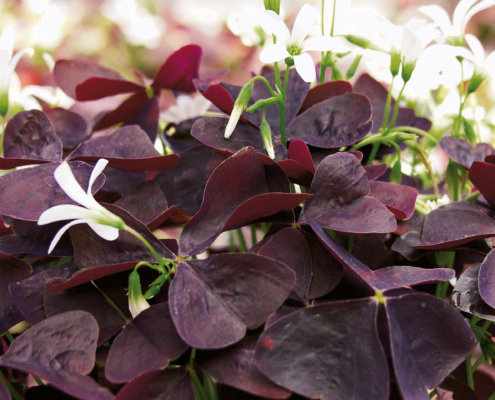
Charmed® Wine Shamrock
This lucky plant is growing in popularity as an indoor foliage plant. The bright purple foliage adds bright pops of color to any room. In the evening the leaves fold down but lift back up in the morning light. The small pink flowers are delicate and attractive. A sunny window with bright, but not direct, light is best and good drainage is a must.
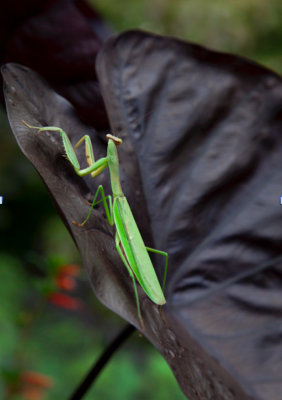
‘Black Velvet’ Elephant Ear
This is a must-have for any houseplant collector. Many people are familiar with giant elephant ears that grow outdoors. ‘Black Velvet’ is a dwarf variety, with nearly black foliage accented with silvery-white veins, a truly striking combination. This tropical loves warm, moist places like kitchens and bathrooms. It prefers bright, but not direct, sun and well-drained soil.
Ready for more? Learn How to Fertilize Houseplants with Homestead Brooklyn
Espoma Products Indoor!, Potting Soil Mix, Cactus Mix
